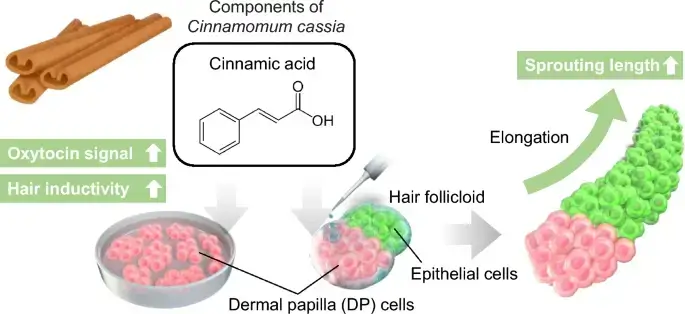In October 2023, Japanese researchers (led by Junji Fukuda and Tatsuto Kageyama) published an interesting paper that concluded that oxytocin has a positive effect on hair growth via upregulation of dermal papilla cell signature markers. These findings were later covered by a NHK News video report from Japan.
Oxytocin (OXT) is better known as the “love hormone”. It is produced and released by women during childbirth and lactation. It is also produced during skin stimulation, such as when hugging or getting a massage. OXT is also called the anti-stress hormone.
In this study, OXT treatment resulted in the upregulation of genes that were associated with hair growth promoting factors. These included VEGFA (a protein encoded by the VEGF gene), PDGFB, FGF7 and BMP2. This ultimately results in peg-like hair sprouting via the improved hair growth ability of dermal papilla cells.
Oxytocin, Cinnamic Acid and Hair Growth
I was 50/50 about writing a post on oxytocin and hair growth. We have seen numerous such past unusual examples that ultimately lead to no actual hair loss products.
However, in February 2023, the same researchers from Japan published yet another study that found cinnamic acid to promote hair growth via the activation of oxytocin receptor (OXTR) expression. Cinnamon is officially known as Cinnamomum cassia, and cinnamic acid is a component of Cinnamomum cassia.
“Treatment with cinnamic acid led to upregulation of OXTR and trichogenic gene expression in human dermal papilla (DP) cells.”
Three people e-mailed me the story about these findings that was published on phy.org several weeks ago. And a few others also posted blog comments about this news. No-one seemed to connect both these Japanese studies if I recall correctly.

Note that cinnamic acid can also be derived naturally from a number of plants. The most famous being cinnamon, shown in the image above. Yet one more ingredient to add in the list of natural treatments for hair loss.
A 2012 study from Japan found that cinnamon extract promotes Type I collagen biosynthesis via the activation of IGF-I signaling in human dermal fibroblasts. Also from 2012, a study from Taiwan concluded that cinnamic aldehyde (a constituent of Cinnamomum cassia) has excellent anti-inflammatory properties.
A 2018 study from Taiwan found that Cinnamomum osmophloeum Kanehira (COK) leaves caused dermal papilla cell proliferation and increased hair growth in mice.

